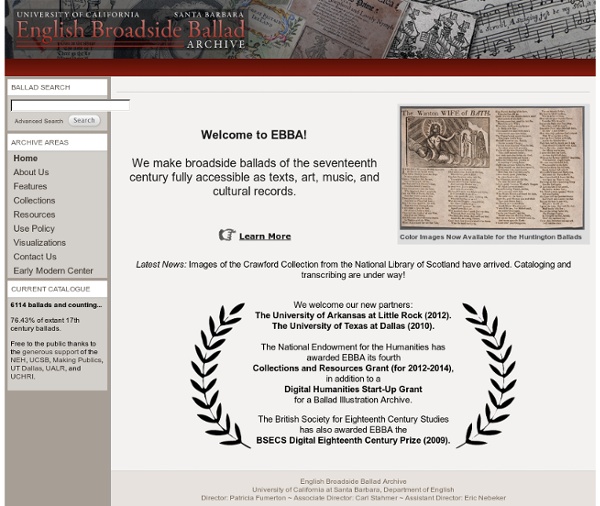



British Printed Images to 1700: Home The English Emblem Book Project Word and Image In recent years, scholars in many disciplines have recognized that the literally thousands of engravings, wood blocks, and etchings in emblem books constitute an unparalleled source not only for the study of daily life of the sixteenth and seventeenth centuries but also for extraordinary insights into what the intellectuals of the times viewed as a necessary adjunct to heraldry, social life, politics, philosophy, and moral behavior. The English emblem books scanned for this project are cultural artifacts frequently used in the analysis of reading practices, printing history, Elizabethan popular culture, the use of allegory, and the relationship of word to image. An emblem combines a picture and text for the striking presentation of a message.
Casket Sewing was an important skill for a woman in the 17th century and was taught to girls of all classes from an early age. Plain sewing - hemming and seaming - was of particular value for the production of underclothes and basic household linens. Only a privileged few, however, were able to afford the time and materials for embroidery. It is probable that each individual figure or element was sewn independently and then applied to the delicate white satin background. Different scenes, almost certainly derived from contemporary prints, adorn each of the five visible surfaces of the casket. Physical description Casket covered in white satin and embroidered with blue, green, pink, brown, yellow and fawn silks in long and short, tent, split, flame, filling and knotted stitches and incorporating raised work and seed pearls. On the lid is an oval compartment with a lady and gentleman in a landscape with buildings. Place of Origin England, Britain (made) Date 1678 (made) Artist/maker Dimensions
Image details | National Trust Images National Trust Images Home Features Photographers News Register or Login Filter search Browse categories Home Image details Close-up of the bottom section of the stumpwork mirror frame in the Great Parlour at Lytes Cary Manor, Somerset Image reference 93438 Image No. Title Caption Close-up of the bottom section of the stumpwork mirror frame in the Great Parlour at Lytes Cary. Property name Lytes Cary Manor County Somerset Image library NTPL Commissioned (NTPL) Photo credit ©National Trust Images/John Hammond Restrictions File size Property released Model release Further copyright Ownership You can now... Add this to basket Add this to lightbox ? Download image preview Related Keywords You may also like to visit Buy this as a print About us Contact us Help using the site Terms & Conditions Privacy policy Accessibility Sitemap Our other National Trust sites The National Trust
Casket or workbox - Collections Online This image is All rights reserved. Please follow the Buy or license link under each image to apply to use this image. (Charges may apply) Why you need to apply for the use of this image Rights for this work may be: controlled by the artist, the artist's estate, or other rights holders; or unclear - Te Papa will do a more detailed analysis of the work’s rights history; or covered by Te Papa’s Mana Taonga principle which supports the rights of holders of traditional knowledge to determine how the image may be used. You need to make sure you don’t infringe on the rights of third parties before you use this image. More information about copyright We recommend these resources for more information: Find more information about Te Papa's rights project on our blog, including how rights types are assigned. Get in touch Please contact copyright@tepapa.govt.nz if you have any information regarding this work and rights to it, or if you wish to contact the rights holder for this work. Related information
Art Resource | Fine Art Stock Licensing Details A silk, wool and linen embroidered panel of a man and woman in a garden surrounded by symbols, peacock, for pride, and cockatrice symbolising lust. Between the couple is the fountain of spirituality. Harmony is music in the form of a woman, playing the lute under a fruiting arbour, c. 1650-1700 Location: Museum of London, London, Great Britain Photo Credit: Museum of London / The Art Archive at Art Resource, NY Image Reference: Image size: 4200 X 3235 px Keywords
Casket Object Type Caskets like this were used by girls in the 17th century for storing small personal possessions. The caskets were fitted inside with a variety of compartments, suitable for keeping jewellery, cosmetics, writing equipment and letters, needlework tools, tiny toys or keepsakes. They often had mirrors set into the lids, for dressing, and sometimes had secret drawers for particularly precious possessions. Ownership & Use The panels would have been worked by a young girl, aged about 11 or 12. Materials & Making This casket has the extremely rare feature of sheets of mica, a shiny transparent mineral that can be easily split. Physical description Wooden needlework casket covered with embroidered silk panels. The upper compartment contains two glass bottles, ring containers, 6 concealed drawers, letter container, 3 apertures and one concealed cavity, a pincushion, an ink and a powder bottle. Place of Origin England, Britain (made) Date 1650-1680 (made) Artist/maker unknown (production)